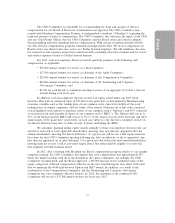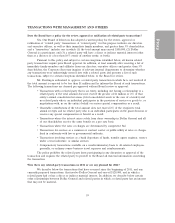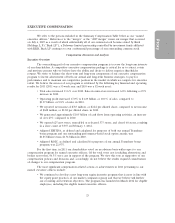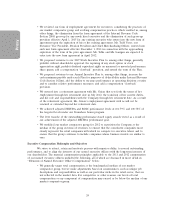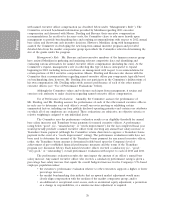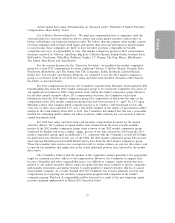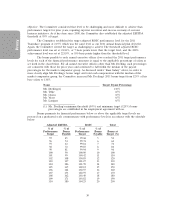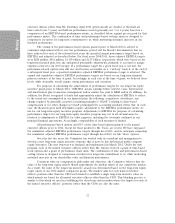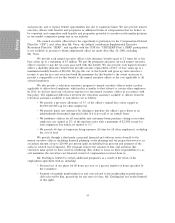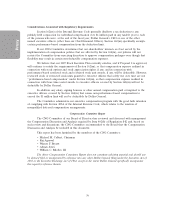Dollar General 2011 Annual Report Download - page 35
Download and view the complete annual report
Please find page 35 of the 2011 Dollar General annual report below. You can navigate through the pages in the report by either clicking on the pages listed below, or by using the keyword search tool below to find specific information within the annual report.
Proxy
Actual annual base salary determinations are discussed under ‘‘Elements of Named Executive
Compensation—Base Salary’’ below.
Use of Market Benchmarking Data. We must pay compensation that is competitive with the
external market for executive talent in order to attract and retain named executive officers who we
believe will enhance our long-term business results. We believe that this primary talent market consists
of retail companies with revenues both larger and smaller than ours and with business models similar
to ours because those companies are likely to have executive positions comparable in breadth,
complexity and scope of responsibility to ours. Our market comparator group for 2011 compensation
decisions consisted of 7-Eleven, AutoZone, Big Lots, Collective Brands, Family Dollar, Genuine Parts,
McDonald’s, Nordstrom, OfficeMax, PetSmart, Staples, J.C. Penney, The Gap, Macy’s, Blockbuster,
The Pantry, Ross Stores and Yum Brands.
For the reasons discussed in the ‘‘Executive Overview’’, we modified this market comparator
group for certain 2012 compensation decisions, replacing 7-Eleven, Collective Brands, Genuine Parts,
Nordstrom, Blockbuster, and The Pantry with TJX Companies, Kohls, Starbucks, Limited Brands,
Dollar Tree, Foot Locker and Safeway. However, we continued to use the 2011 market comparator
group as a reference point in our 2012 base salary and short-term incentive decisions (other than for
the CEO), as described below.
For 2011 compensation decisions, the Committee requested that Meridian obtain updated CEO
benchmarking data from the 2011 market comparator group to be certain the Committee was aware of
any significant movement in CEO compensation levels within the market comparator group. However,
for all other named executive officer 2011 compensation decisions, the Committee relied upon
information from the 2010 market comparator group (the composition of which was the same as the
composition of the 2011 market comparator group) that had been increased or ‘‘aged’’ by 2.5% upon
Meridian’s advice that common public company practice is to conduct a full benchmark review only
every two or three years and that 2.5% was a reasonable estimate of the degree of movement in officer
salaries in the retail industry from 2010 to 2011. The Committee determined that this was a reasonable
method for estimating market salaries for officer positions, while reducing the cost associated with an
annual benchmark study.
For 2012 base salary and short-term cash incentive compensation decisions for the named
executive officers, the Company averaged market data obtained from the most recently available
proxies of the 2012 market comparator group, from a survey of our 2012 market comparator group
conducted by Equilar and from a similar ‘‘aging’’ process of the data obtained in 2010 from the 2011
market comparator group, aged an additional 2.7%, consistent with the Company’s overall 2012 budget
for merit increases. However, in the case of the CEO, the 2011 market comparator group data was not
used; instead, Meridian provided AON Hewitt survey data from the 2012 market comparator group.
These three market data sources were averaged in order to reduce reliance on any one data source and
to smooth out anomalies that might exist in the actual individual position data reported by the market
data source.
The Committee believes that the median of the competitive market generally is the appropriate
target for a named executive officer’s total compensation. However, the Committee recognizes that,
because of liquidity and other comparability issues, it is difficult to compare equity awards that were
granted to our named executive officers under an equity structure more common to private companies
with transfer restrictions and similar features to equity granted to named executive officers of a more
typical public company. As a result, through 2011 the Committee has focused primarily on total cash
compensation in comparing our executive compensation program with companies in the market
comparator group. This lack of comparability will be lessened as a result of the new long-term equity
incentive program implemented in March 2012 described below.
27


